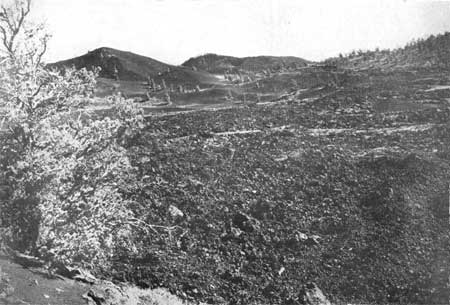
|
Idaho Bureau of Mines and Geology Bulletin
Craters of the Moon National Monument, Idaho |
UNUSUAL OCCURRENCE OF WATER.
The visitor to the Craters of the Moon on a hot July day is amazed at the ice-cold water found in the most unexpected places. The temperature of the water rarely exceeds 34° F. There are three kinds of places where water or ice is found. Most of the large water holes occur in depressions in very rough, broken lava. In these depressions, a considerable amount of snow collects in winter. Some of it sifts down into the crevices between the rocks and remains sheltered from the hot atmosphere during the long summer days. In addition, water during the thawing periods in the autumn or spring may drip downward into the crevices, where it is frozen by cold circulating air. During the long cold winters ice forms. Some of it melts in the summer, but in favored locations it never melts entirely away. Just as the solid lava is a poor conductor for the upward movement of heat from the molten lava beneath, so it is a poor conductor for the downward passage of heat from the sun. Usually a small amount of ice melts during the summer and forms a pool of water. On digging down into the loose rock in a water hole of this type, ice will always be found beneath the water.
Water and ice also occur in the lava caves or tubes where drafts of cold air freeze any water that percolates into them. The freezing period covers about seven months in the year, and during the remaining months there is a gradual wasting away of the ice. Even during the summer days the temperature of the interior of the caves does not rise above 40° F.; hence melting proceeds very slowly. Ice and water are also found in the deep inverted-funnel craters of the spatter cones, such as the Ice Cave. In occurrences of this type the snow accumulates in the crater during the winter and is exposed to the direct rays of the sun for only a short time each day. Thus, there results a continually increasing heap of Ice, The Ice Cave, near the end of the road, is of this type and contains a heap of snow and ice about 20 feet thick. The locations of the perennial water holes are given on page 56.

|
| PLATE XV—The rough, bristling, jagged kind of lava is known as aa. Walking over such rock is extremely slow and hazardous. View of the Northeast lava flow from Big Craters Butte. Photograph by H. T. Stearns. |
Many people imagine that some uncanny, mysterious method accounts for the formation of the ice, such as impossible chemical reactions and queer volcanic phenomena. On the active volcano of Kilauea, Hawaii, where thousands of similar caves occur and where immense quantities of rain fall, no ice occurs in the caves, but the explanation is apparent, for Kilauea has neither snow nor freezing temperature. On the other hand, Mauna Loa Volcano, which rises nearly 14,000 feet above the sea, into the snow zone, contains numerous ice caves in and near the crater, and many of them are only a stone's throw from a steam vent. Ice caves do not occur anywhere in the world except where there are freezing temperatures during some part of the year.
The lava in the Craters of the Moon is so extensively fissured that no water is found in it throughout the year except where the water is perched upon an impermeable body of ice and lava.
| <<< Previous | <<< Contents >>> | Next >>> |
id/1928-13/sec9.htm
Last Updated: 28-Mar-2006